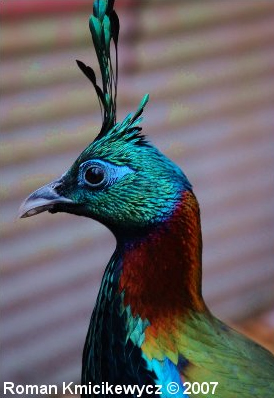 Other Names: Impeyan Pheasant, Impeyan Monal
Other Names: Impeyan Pheasant, Impeyan Monal
Range: The Himalayas, from eastern Afghanistan to western China
Subspecies: None recognized at this time, but current studies may place birds in northwestern India has a new subspecies as they lack the white rump and have more green on breast.
Habitat: Mountainous regions; in summer, they are found in rocky, grass covered meadows and winters in coniferous and mixed forests.
Description: The males are adorned with beautiful metallic colors of green, purple, red and blue; they also have a large white patch on the rump. The breast and underparts are black and the tail is copper. You can see from the photograph on the right, that the males also have a very long crest, much like a peacock. The male also has a bare patch of turquoise blue skin around the eye.The hens, while much duller than the male, are still attractive. They are basically mottled brown overall, with black, buff and white streaks. Her throat is white and she has a short crest. Hens also have the blue patch around the eyes. First year males resemble the hens, but are larger and have black feathers on the neck and breast.
Status in Wild: Considered stable throughout much of its range, but may have been eliminated in Afganistan.
Interesting Facts: The national bird of Nepal. Commonly called the Impeyan after Lady Impey who first kept them in captivity.
Status in Aviculture: The Himalayan Monal is the most commonly kept species of the genus Lophophorus and are well established in North American and European aviaries.
Breeding Season: Begins late April
Breeding Age: Second year.
Clutch Size: 4 to 6
Incubation Period: 28 days



